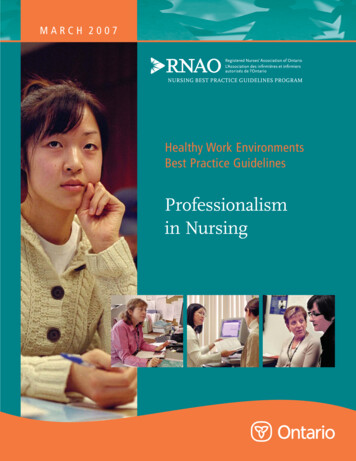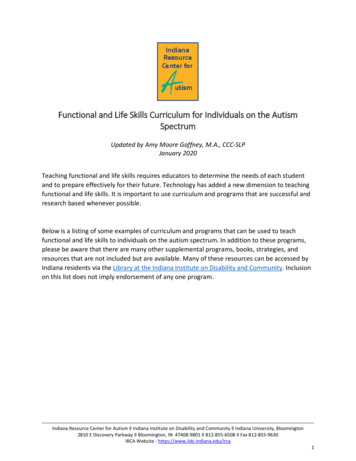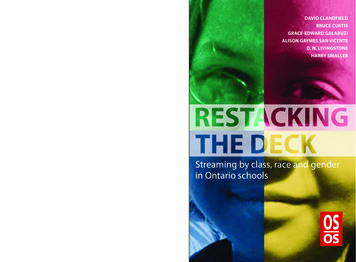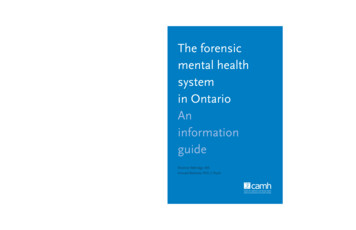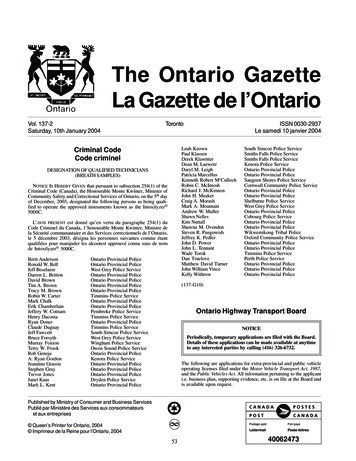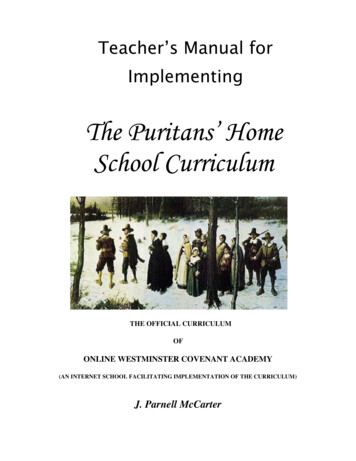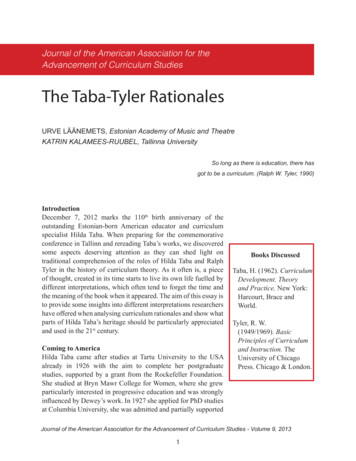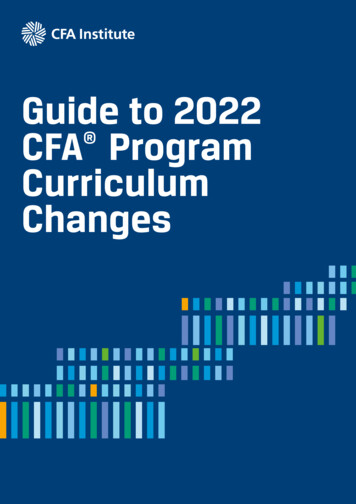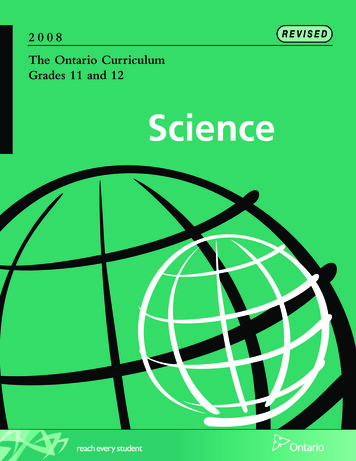
Transcription
REVISED2008The Ontario CurriculumGrades 11 and 12Science
ContentsINTRODUCTION3Secondary Schools for the Twenty-first Century . . . . . . . . . . . . . . . . . . . . . . . . . . . . . . . . . . . . . . . . . . . . . . . . .The Place of Science in the Curriculum . . . . . . . . . . . . . . . . . . . . . . . . . . . . . . . . . . . . . . . . . . . . . . . . . . . . . . . . . . . .The Goals of the Science Program . . . . . . . . . . . . . . . . . . . . . . . . . . . . . . . . . . . . . . . . . . . . . . . . . . . . . . . . . . . . . . . . . .The Nature of Science . . . . . . . . . . . . . . . . . . . . . . . . . . . . . . . . . . . . . . . . . . . . . . . . . . . . . . . . . . . . . . . . . . . . . . . . . . . . . . . . .Roles and Responsibilities in the Science Program . . . . . . . . . . . . . . . . . . . . . . . . . . . . . . . . . . . . . . . . . . . . . .THE PROGRAM IN SCIENCE3344710Overview of the Program . . . . . . . . . . . . . . . . . . . . . . . . . . . . . . . . . . . . . . . . . . . . . . . . . . . . . . . . . . . . . . . . . . . . . . . . . . . 10Curriculum Expectations . . . . . . . . . . . . . . . . . . . . . . . . . . . . . . . . . . . . . . . . . . . . . . . . . . . . . . . . . . . . . . . . . . . . . . . . . . . . 14Strands in the Grade 11 and 12 Science Courses . . . . . . . . . . . . . . . . . . . . . . . . . . . . . . . . . . . . . . . . . . . . . . 17Skills of Scientific Investigation (Inquiry and Research) . . . . . . . . . . . . . . . . . . . . . . . . . . . . . . . . . . . . . . . 20ASSESSMENT AND EVALUATION OF STUDENT ACHIEVEMENTBasic Considerations . . . . . . . . . . . . . . . . . . . . . . . . . . . . . . . . . . . . . . . . . . . . . . . . . . . . . . . . . . . . . . . . . . . . . . . . . . . . . . . . .The Achievement Chart for Science . . . . . . . . . . . . . . . . . . . . . . . . . . . . . . . . . . . . . . . . . . . . . . . . . . . . . . . . . . . . . .Evaluation and Reporting of Student Achievement . . . . . . . . . . . . . . . . . . . . . . . . . . . . . . . . . . . . . . . . . . .Reporting on Demonstrated Learning Skills . . . . . . . . . . . . . . . . . . . . . . . . . . . . . . . . . . . . . . . . . . . . . . . . . . . .SOME CONSIDERATIONS FOR PROGRAM PLANNINGInstructional Approaches . . . . . . . . . . . . . . . . . . . . . . . . . . . . . . . . . . . . . . . . . . . . . . . . . . . . . . . . . . . . . . . . . . . . . . . . . . .Health and Safety in Science . . . . . . . . . . . . . . . . . . . . . . . . . . . . . . . . . . . . . . . . . . . . . . . . . . . . . . . . . . . . . . . . . . . . . . .Planning Science Programs for Students With Special Education Needs . . . . . . . . . . . . . . . . .Program Considerations for English Language Learners . . . . . . . . . . . . . . . . . . . . . . . . . . . . . . . . . . . . .Environmental Education. . . . . . . . . . . . . . . . . . . . . . . . . . . . . . . . . . . . . . . . . . . . . . . . . . . . . . . . . . . . . . . . . . . . . . . . . . .Antidiscrimination Education . . . . . . . . . . . . . . . . . . . . . . . . . . . . . . . . . . . . . . . . . . . . . . . . . . . . . . . . . . . . . . . . . . . . . .Critical Thinking and Critical Literacy in Science . . . . . . . . . . . . . . . . . . . . . . . . . . . . . . . . . . . . . . . . . . . . . . .Literacy, Mathematical Literacy, and Investigation (Inquiry/Research) Skills . . . . . . . . . . . . .The Role of Information and Communications Technology in Science . . . . . . . . . . . . . . . . . . .Une publication équivalente est disponible en français sous le titresuivant : Le curriculum de l’Ontario, 11e et 12e année – Sciences, 2008.This publication is available on the Ministry of Education’s website,at www.edu.gov.on.ca.232325303031313233363839404142
The Ontario Skills Passport and Essential Skills . . . . . . . . . . . . . . . . . . . . . . . . . . . . . . . . . . . . . . . . . . . . . . . . .Career Education . . . . . . . . . . . . . . . . . . . . . . . . . . . . . . . . . . . . . . . . . . . . . . . . . . . . . . . . . . . . . . . . . . . . . . . . . . . . . . . . . . . . .Cooperative Education and Other Forms of Experiential Learning . . . . . . . . . . . . . . . . . . . . . . . .Planning Program Pathways and Programs Leading toa Specialist High Skills Major . . . . . . . . . . . . . . . . . . . . . . . . . . . . . . . . . . . . . . . . . . . . . . . . . . . . . . . . . . . . . . . . . . . . . . .43434344CoursesBiologyBiology, Grade 11, University Preparation (SBI3U) . . . . . . . . . . . . . . . . . . . . . . . . . . . . . . . . . . . . . . . . . . . . . 46Biology, Grade 11, College Preparation (SBI3C ). . . . . . . . . . . . . . . . . . . . . . . . . . . . . . . . . . . . . . . . . . . . . . . . 60Biology, Grade 12, University Preparation (SBI4U) . . . . . . . . . . . . . . . . . . . . . . . . . . . . . . . . . . . . . . . . . . . . . 74ChemistryChemistry, Grade 11, University Preparation (SCH3U) . . . . . . . . . . . . . . . . . . . . . . . . . . . . . . . . . . . . . . . . 90Chemistry, Grade 12, University Preparation (SCH4U) . . . . . . . . . . . . . . . . . . . . . . . . . . . . . . . . . . . . . . . 104Chemistry, Grade 12, College Preparation (SCH4C) . . . . . . . . . . . . . . . . . . . . . . . . . . . . . . . . . . . . . . . . . . 118Earth and Space ScienceEarth and Space Science, Grade 12, University Preparation (SES4U) . . . . . . . . . . . . . . . . . . . . . . 134Environmental ScienceEnvironmental Science, Grade 11, University/College Preparation (SVN3M) . . . . . . . . . . . 150Environmental Science, Grade 11, Workplace Preparation (SVN3E) . . . . . . . . . . . . . . . . . . . . . . . 164PhysicsPhysics, Grade 11, University Preparation (SPH3U) . . . . . . . . . . . . . . . . . . . . . . . . . . . . . . . . . . . . . . . . . . . 180Physics, Grade 12, University Preparation (SPH4U) . . . . . . . . . . . . . . . . . . . . . . . . . . . . . . . . . . . . . . . . . . . 194Physics, Grade 12, College Preparation (SPH4C) . . . . . . . . . . . . . . . . . . . . . . . . . . . . . . . . . . . . . . . . . . . . . . 208ScienceScience, Grade 12, University/College Preparation (SNC4M) . . . . . . . . . . . . . . . . . . . . . . . . . . . . . . . 224Science, Grade 12, Workplace Preparation (SNC4E) . . . . . . . . . . . . . . . . . . . . . . . . . . . . . . . . . . . . . . . . . . 238Glossary253
INTRODUCTIONThis document replaces The Ontario Curriculum, Grades 11 and 12: Science, 2000. Beginningin September 2009, all science programs for Grades 11 and 12 will be based on the expectations outlined in this document.SECONDARY SCHOOLS FOR THE TWENTY-FIRST CENTURYThe goal of Ontario secondary schools is to support high-quality learning while givingindividual students the opportunity to choose programs that suit their skills and interests.The updated Ontario curriculum, in combination with a broader range of learning optionsoutside traditional classroom instruction, will enable students to better customize theirhigh school education and improve their prospects for success in school and in life.THE PLACE OF SCIENCE IN THE CURRICULUMDuring the twentieth century, science played an increasingly important role in the lives of allCanadians. It underpins much of what we now take for granted, from life-saving pharmaceuticals to clean water, the places we live and work in, computers and other informationtechnologies, and how we communicate with others. The impact of science on our lives willcontinue to grow as the twenty-first century unfolds. Consequently, scientific literacy for allhas become a goal of science education throughout the world and has been given expressionin Canada in the Common Framework of Science Learning Outcomes, K to 12: Pan-CanadianProtocol for Collaboration on School Curriculum (Council of Ministers of Education, Canada,1997). Scientific literacy can be defined as possession of the scientific knowledge, skills, andhabits of mind required to thrive in the science-based world of the twenty-first century.A scientifically and technologically literate person is one who can read and understandcommon media reports about science and technology, critically evaluate the informationpresented, and confidently engage in discussions and decision-making activitiesregarding issues that involve science and technology.Science Co-ordinators’ and Consultants’ Association of Ontario (SCCAO)and Science Teachers’ Association of Ontario (STAO/APSO),“Position Paper: The Nature of Science” (2006), p. 1Achieving a high level of scientific literacy is not the same as becoming a scientist. Thenotion of thriving in a science-based world applies as much to a small-business person,a lawyer, a construction worker, a car mechanic, or a travel agent as it does to a doctor, anengineer, or a research scientist. While the specific knowledge and skills required for eachof these occupations vary, the basic goal of thriving in a science-based world remains thesame. Science courses have been designed for a wide variety of students, taking intoaccount their interests and possible postsecondary destinations. Some courses have beendesigned to serve as preparation for specialist studies in science-related fields; others
have been designed for students intending to go on to postsecondary education but notto study science; yet others have been designed with the needs of the workplace inmind. The overall intention is that all graduates of Ontario secondary schools will achieveexcellence and a high degree of scientific literacy while maintaining a sense of wonderabout the world around them. Accordingly, the curriculum reflects new developmentson the international science scene and is intended to position science education inOntario at the forefront of science education around the world.THE GOALS OF THE SCIENCE PROGRAMAchievement of both excellence and equity underlies the three major goals of the secondaryscience program. The Ontario Curriculum, Grades 11 and 12: Science, 2008 therefore outlinesnot only the skills and knowledge that students are expected to develop but also theattitudes that they will need to develop in order to use their knowledge and skillsresponsibly. The three goals of the science program are as follows:1. to relate science to technology, society, and the environment2. to develop the skills, strategies, and habits of mind required for scientific inquiry3. to understand the basic concepts of scienceEvery course in the secondary science program focuses on these three goals. The goals arereflected within each strand of every course in the three overall expectations, which inturn are developed in corresponding sets of related specific expectations. The same threegoals also underlie assessment of student achievement in science.THE ONTARIO CURRICULUM, GRADES 11 AND 12 ScienceTHE NATURE OF SCIENCE The primary goal of science is to understand the natural and human-designed worlds.Science refers to certain processes used by humans for obtaining knowledge aboutnature, and to an organized body of knowledge about nature obtained by theseprocesses. Science is a dynamic and creative activity with a long and interestinghistory. Many societies have contributed to the development of scientific knowledgeand understanding. . . . Scientists continuously assess and judge the soundness ofscientific knowledge claims by testing laws and theories, and modifying them in lightof compelling new evidence or a re-conceptualization of existing evidence.SCCAO and STAO/APSO, “Position Paper: The Nature of Science” (2006), pp. 1–2Science is a way of knowing that seeks to describe and explain the natural and physicalworld. An important part of scientific literacy is an understanding of the nature of science, which includes an understanding of the following: what scientists, engineers, and technologists do as individuals and as a community how scientific knowledge is generated and validated, and what benefits, costs, andrisks are involved in using this knowledge how science interacts with technology, society, and the environmentOccasionally, theories and concepts undergo change, but for the most part, the fundamental concepts of science – to do with phenomena such as the cellular basis of life, thelaws of energy, the particle theory of matter – have proved stable.
Fundamental ConceptsChange the focus of the curriculum and instruction from teaching topics to “using”topics to teach and assess deeper, conceptual understanding.Lynn Erickson, Concept-Based Curriculum and Instruction (2006), p. 7Fundamental concepts are concepts about phenomena that have not changed fundamentally over time and that are common for all cultures. The fundamental concepts in scienceprovide a framework for the deeper understanding of all scientific knowledge – a structurethat facilitates integrated thinking as students draw from the knowledge base of scienceand see patterns and connections within the subdisciplines of science, and between scienceand other disciplines. The fundamental concepts addressed in the curricula for science andtechnology in Grades 1 to 8 and for science in Grades 9 to 12 are similar to concepts foundin science curricula around the world.As students progress through the curriculum from Grades 1 to 12, they extend and deepentheir understanding of these fundamental concepts and learn to apply their understandingwith increasing sophistication. The fundamental concepts are listed and described in thefollowing chart.FUNDAMENTAL CONCEPTSMatterMatter is anything that has mass and occupies space. Matter hasparticular structural and behavioural characteristics.EnergyEnergy comes in many forms, and can change forms. It is requiredto make things happen (to do work). Work is done when a forcecauses movement.Systems andInteractionsA system is a collection of living and/or non-living things andprocesses that interact to perform some function. A system includesinputs, outputs, and relationships among system components. Naturaland human systems develop in response to, and are limited by, avariety of environmental factors.Structureand FunctionThis concept focuses on the interrelationship between the function oruse of a natural or human-made object and the form that the object takes.Sustainabilityand StewardshipSustainability is the concept of meeting the needs of the present without compromising the ability of future generations to meet their needs.Stewardship involves understanding that we need to use and care forthe natural environment in a responsible way and making the effort topass on to future generations no less than what we have access toourselves. Values that are central to responsible stewardship are: usingnon-renewable resources with care; reusing and recycling what wecan; switching to renewable resources where possible.Change andContinuityChange is the process of becoming different over time, and can bequantified.IntroductionContinuity represents consistency and connectedness within andamong systems over time. Interactions within and among systemsresult in change and variations in consistency.
“Big Ideas”Big ideas “go beyond discrete facts or skills to focus on larger concepts, principles, orprocesses.”Grant Wiggins and Jay McTighe, Understanding by Design (1998), p. 10“Big ideas” are the broad, important understandings that students should retain longafter they have forgotten many of the details of what they have studied in the classroom.They are the understandings that contribute to scientific literacy. The big ideas that students can take away from each course in this curriculum relate to some aspect of thefundamental concepts described in the preceding section. A list of the big ideas studentsneed to understand appears at the start of every course in this document.Developing a deeper understanding of the big ideas requires students to understandbasic concepts, develop inquiry and problem-solving skills, and connect these conceptsand skills to the world beyond the classroom. Teachers can help students gain suchunderstanding by connecting learning based on the overall and specific expectations andthe criteria in the achievement chart to the big ideas that relate to each course.The relationship between the fundamental concepts, big ideas, the goals of the scienceprogram, and the overall and specific expectations is outlined in the chart that follows.Fundamental ConceptsMatterEnergySystems andInteractionsStructure andFunctionSustainabilityand StewardshipChange andContinuityBIG IDEASTHE ONTARIO CURRICULUM, GRADES 11 AND 12 ScienceThe Goals of Science Goal 1To relate science totechnology, society,and the environmentGoal 2To develop the skills,strategies, and habitsof mind required forscientific inquiryGoal 3To understand the basicconcepts of scienceOverall Expectation 1Overall Expectation 2Overall Expectation 3Specific ExpectationsRelating science totechnology, society,and the environmentSpecific ExpectationsDeveloping skills ofscientific investigationand communicationSpecific ExpectationsUnderstanding basicconcepts
ROLES AND RESPONSIBILITIES IN THE SCIENCE PROGRAMStudentsStudents have many responsibilities with regard to their learning, and these increase as theyadvance through secondary school. Students who are willing to make the effort requiredand who are able to monitor their thinking and learning strategies and apply themselveswill soon discover that there is a direct relationship between this effort and their achievement, and will therefore be more motivated to work. Students who develop mental attitudesand ways of behaving that contribute to success in life will benefit as learners.Successful mastery of scientific concepts and investigation skills requires students tohave a sincere commitment to work and to the development of appropriate learningskills. Furthermore, students should actively pursue opportunities outside the classroomto extend and enrich their scientific understanding and skills. For example, students canmake an effort to keep up with current events related to local, national, and internationalscientific discoveries and innovations.ParentsStudies show that students perform better in school if their parents1 are involved in theireducation. Parents who are familiar with the curriculum expectations know what is beingtaught in the courses their children are taking and what their children are expected tolearn. This awareness enhances parents’ ability to discuss school work with their children, to communicate with teachers, and to ask relevant questions about their children’sprogress. Knowledge of the expectations in the various courses also helps parents to interpret teachers’ comments on student progress and to work with teachers to improvetheir children’s learning.Effective ways in which parents can support their children’s learning include the following:attending parent-teacher interviews, participating in parent workshops and school councilactivities (including becoming a school council member), and encouraging their childrento complete their assignments at home.The science curriculum has the potential to stimulate interest in lifelong learning not onlyfor students but also for their parents and all those with an interest in education. In additionto supporting regular school activities, parents may want to take an active interest in currentevents and issues in the field of science, and to provide their children with opportunitiesto question and reflect on the impact of these developments on their immediate lives, theenvironment, and society. Parents can also provide valuable support by encouraging childrento take part in activities that develop responsible citizenship (such as participating in anenvironmental clean-up program in their neighbourhood) or that further their interest inscience (such as volunteering at local science centres or children’s museums).1. In this document, parent(s) is used to refer to parents and guardians.IntroductionThroughout the secondary science program, students will have opportunities to interactwith living things and to work with a variety of equipment and materials. To help ensurestudents’ safety, parents should inform teachers of any allergies that their children mayhave. Parents should also encourage their children to arrive at school prepared to participate safely in activities. Simple precautions such as wearing closed-toe shoes, tying backlong hair, and removing loose jewellery (or taping it down in the case of Medic Alertbracelets) contribute to a safe environment when working within science classrooms.
TeachersTeachers are responsible for developing appropriate instructional strategies to help studentsachieve the curriculum expectations, as well as appropriate methods for assessing andevaluating student learning. Teachers bring enthusiasm and varied teaching and assessment approaches to the classroom, addressing individual students’ needs and ensuringsound learning opportunities for every student.Using a variety of instructional, assessment, and evaluation strategies, teachers providenumerous hands-on opportunities for students to develop and refine their investigationskills, including their problem-solving skills, critical and creative thinking skills, andcommunication skills, while discovering fundamental concepts through inquiry, exploration, observation, and research. The activities offered should enable students to relate andapply these concepts to the social, environmental, and economic conditions and concernsof the world in which they live. Opportunities to relate knowledge and skills to thesewider contexts will motivate students to learn in a meaningful way and to become lifelong learners.Teachers need to help students understand that problem solving of any kind often requiresa considerable expenditure of time and energy and a good deal of perseverance. Teachersalso need to encourage students to investigate, to reason, to explore alternative solutions,and to take the risks necessary to become successful problem solvers.Science can play a key role in shaping students’ views about life and learning. Scienceexists in a broader social and economic context. It is affected by the values and choices ofindividuals, businesses, and governments and, in turn, has a significant impact on societyand the environment. Teachers must provide opportunities for students to develop habitsof mind appropriate for meaningful work in science, including a commitment to accuracy,precision, and integrity in observation; respect for evidence; adherence to safety procedures;and respect for living things and the environment.THE ONTARIO CURRICULUM, GRADES 11 AND 12 ScienceTeachers are also responsible for ensuring the safety of students during classroom activitiesand for encouraging and motivating students to assume responsibility for their own safetyand the safety of others. They must also ensure that students acquire the knowledge andskills needed for safe participation in science activities. PrincipalsThe principal works in partnership with teachers and parents to ensure that each studenthas access to the best possible educational experience. The principal is also a communitybuilder who creates an environment that is welcoming to all, and who ensures that allmembers of the school community are kept well informed.To support student learning, principals ensure that the Ontario curriculum is being properlyimplemented in all classrooms through the use of a variety of instructional approaches andthat appropriate resources are made available for teachers and students. To enhance teaching and student learning in all subjects, including science, principals promote learningteams and work with teachers to facilitate teacher participation in professional development activities. Principals are responsible for ensuring that every student who has anIndividual Education Plan (IEP) is receiving the modifications and/or accommodationsdescribed in his or her plan – in other words, that the IEP is properly developed, implemented, and monitored.
Community PartnersCommunity partners in areas related to science can be an important resource for schoolsand students. They can provide support for students in the classroom and can be models ofhow the knowledge and skills acquired through the study of the curriculum relate to lifebeyond school. As mentors, they can enrich not only the educational experience of studentsbut also the life of the community. For example, schools can make use of community groupsthat recruit practising scientists (e.g., engineers, optometrists, veterinarians, geologists, labtechnicians) to provide in-class workshops for students that are based on topics, concepts,and skills from the curriculum.Schools and school boards can play a role by coordinating efforts with community partners. They can involve community volunteers in supporting science instruction and inpromoting a focus on scientific literacy in and outside the school. Community partnerscan be included in events held in the school (such as parent education nights and sciencefairs), and school boards can collaborate with leaders of existing community science programs for students, including programs offered in community centres, libraries, and localmuseums and science centres.Introduction
THE PROGRAMIN SCIENCEOVERVIEW OF THE PROGRAMThe overall aim of the secondary science program is to ensure scientific literacy for everysecondary school graduate. To better achieve this aim, all courses in the program are designed to focus on science not only as an intellectual pursuit but also as an activity-basedenterprise within a social context.The senior science courses build on the Grade 9 and 10 science program, incorporating thesame goals of science and fundamental concepts on which that program was based. Bothprograms are founded on the premise that students learn science most effectively whenthey are active participants in their own learning. Such participation is achieved whenscience concepts and procedures are introduced through an investigative approach and areconnected to students’ prior knowledge in meaningful ways. The Grade 11 and 12 sciencecurriculum is designed to help students prepare for university, college, or the workplaceby building a solid conceptual and procedural foundation in science that enables them toapply their knowledge and skills in a variety of ways and successfully further their learning.An important component of every course in the science program is the development ofstudents’ ability to relate science to technology, society, and the environment. Studentsare encouraged to apply their understanding of science to real-world situations in theseareas and to develop knowledge, skills, and attitudes that they will take with them beyond the science classroom.The Grade 11 and 12 science program is designed to help students become scientificallyliterate. One aspect of scientific literacy is the ability to recognize, interpret, and producerepresentations of scientific information in forms ranging from written and oral reports,drawings and diagrams, and graphs and tables of values to equations, physical models,and computer simulations. As students’ scientific knowledge and skills develop throughthe grades, they will become conversant with increasingly sophisticated forms andrepresentations of scientific information.The senior science curriculum also builds on students’ experience with a variety of thesophisticated yet easy-to-use computer applications and simulations that are so prevalentin today’s world. The curriculum integrates these technologies into the learning anddoing of science in ways that help students develop investigation skills, extend their10
understanding of scientific concepts, enable them to solve meaningful problems, andfamiliarize them with technologies that can be applied in various other areas of endeavour.In this curriculum, technology does not replace skills acquisition; rather, it is treated as alearning tool that helps students explore concepts and hone skills.A balanced science program must include varied opportuniti
IntRoDUCtIon This document replaces The Ontario Curriculum, Grades 11 and 12: Science, 2000.Beginning in September 2009, all science programs for Grades 11 and 12 will
